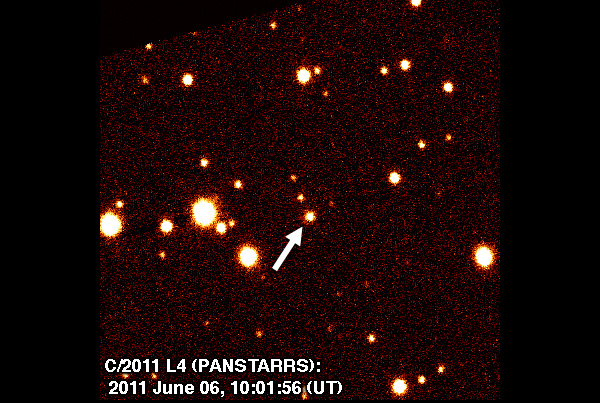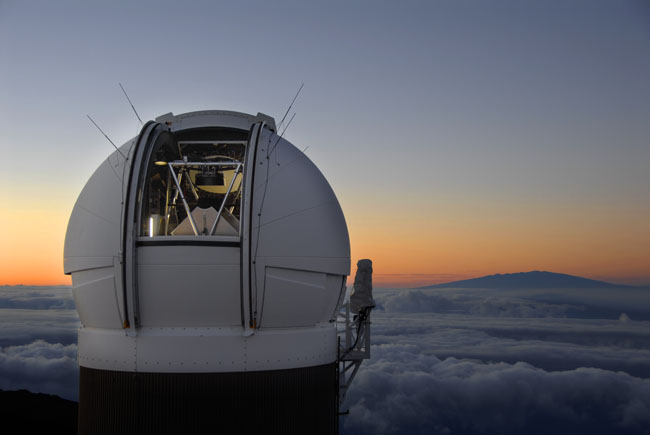
A year from now, it is possible that "comet fever" will be running high when a newfound comet emerges into view in the evening sky. But while some scientists have high hopes for a spectacular 2013 sky show by the comet, it is still far from certain.
When astronomers at the University of Hawaii at Manoa announced last June that they had discovered the new comet, it was a distant and inconspicuous object. But preliminary calculations at once made it clear that this new object had the potential to become a naked-eye object of considerable interest for skywatching enthusiasts in the Northern Hemisphere. The comet may ultimately shine as bright as some of the brightest stars in the night sky, but will likely pale in comparison to the brilliant planet Venus.
The comet was christened C/2011 L4 (PANSTARRS). Comets are usually named after their discoverers, but in this case a large team of observers, computer scientists, and astronomers was involved, so the comet was named after the telescope.
PANSTARRS stands for Panoramic Survey Telescope And Rapid Response System. It's a 1.8-meter prototype for a quartet of military-funded telescopes that astronomers hope to build on the lip of the extinct volcano Haleakala.
Finding Comet PANSTARRS
The comet was initially photographed on June 6 and was confirmed the following day. Actually, the comet had been unknowingly imaged nearly two weeks earlier, on May 24 from Arizona’s Mount Lemmon Observatory. [Amazing Photos of Halley's Comet]
When it was discovered in the constellation Libra, Comet PANSTARRS was a 19th-magnitude object — so faint that only telescopes with sensitive electronic detectors could pick it up — some 759 million miles (1.2 billion kilometers) from the sun.
Get the Space.com Newsletter
Breaking space news, the latest updates on rocket launches, skywatching events and more!
Astronomers measure the brightness of objects in space on a reverse scale; the higher an object's magnitude, the dimmer it appears to observers. The comet was so far away that at first there was difficulty in pinning down the exact date of when it would arrive at perihelion – its closest point to the sun. Initial estimates suggested anytime from early next February to the middle of April of 2013.
When I first wrote about comet PANSTARRS June 27 of last year, the date of perihelion was set for next April 17. But I also said at the time: “It may yet change again, so stay tuned.”
And so it did, to March 9, 2013 — less than one year from today.
The comet will pass to within 28 million miles (45 million kilometers) of the sun on that date. Such an enormous change in solar distance would cause a typical comet to increase in brightness dramatically. And indeed, the comet has responded to the increasing solar warmth as it has approached the sun.
On Feb. 13, the comet had brightened to magnitude 14.5, or in other words, it had increased in brightness by more than 60 times since it was first seen last June. The comet still has a long way to go — it’s still over 500 million miles (820 million km) from both the sun and Earth — out near the orbit of Jupiter. But it still appears on target to possibly become a bright naked eye object by this time next year.

How bright could Comet PANSTARRS get?
Just how bright Comet PANSTARRS will ultimately be still cannot be reliably predicted.
Estimates (or maybe really "guesstimates") suggest that at perihelion on March 9, the comet might become as bright as zero magnitude, placing it in the same rank as the stars Arcturus, Vega and Capella; which are some of the brightest stars in the sky. Thereafter, the comet's rapid northward motion, owing to its orbital inclination of 84 degrees to the plane of the solar system will gradually carry it away from the sun and into the western evening sky.
If there is a significant tail, it would probably be seen protruding almost straight up and perhaps tilted slightly to the right, relative to the horizon. But as is the case with the comet’s brightness, we can only guess just how long it will be. [Best Comet Close Encounters Ever]
In the week following its closest approach to the sun, the head of the comet will be positioned less than 6 degrees above the horizon during late-twilight; about an hour or so after sunset. You can measure how low this is by recalling that your clenched fist held at arm’s length measures roughly 10 degrees in width.
So Comet PANSTARRS will be only about "half a fist" above the horizon as the sky is getting appreciably dark.
On the evening of March 12, the slender sliver of a crescent moon, just one day past new, will be positioned less than 5 degrees to the right of the comet, making for perhaps a very picturesque scene. Prospective observers will need to seek the most favorable conditions possible.
Even a potentially bright comet, like this one, can be easily obliterated by thin horizon clouds, haze, humid air, smoke, sunset glow or city lights. Binoculars or a small telescope are recommended for locating both the moon and the comet.
Skywatching treat of comet PANSTARRS
On successive evenings in March 2013, comet PANSTARRS will grow fainter, it will continue to get farther from the sun, setting later and visible in a darker sky. During April, the comet will become well placed for observing with small telescopes; on the evenings of April 2 and 3 it will be sliding within a couple of degrees of the Great Andromeda Galaxy.
By mid-April the comet will become circumpolar — that is, it will remain above the horizon all night as seen from mid-northern latitudes; during late April it will appear to pass through the famous "W" of Cassiopeia.
The only possible drawback to a possible bright apparition of this comet is the fact that even after more than 200 precise positions; the orbit of comet PANSTARRS does not differ significantly from a parabola. In other words, it may never have passed near the sun before.
That's bad news, because we believe that such comets might be covered with very volatile materials such as frozen nitrogen, carbon monoxide, and carbon dioxide. These ices vaporize far from the sun, giving a distant comet a short-lived surge in brightness that can raise very unrealistic expectations.
If, on the other hand, PANSTARRS is making a return loop around the sun, then its highly volatile materials will have already been shed and what we’ll see in the months to come is the true underlying level of its activity.
All we say for sure at this point is that we have a much better idea of the path the comet is going to take in the coming weeks and months. Unless it begins to sputter out later this year, it’s still on track to become a celestial showpiece a year from now. We’ll keep an eye on it and continue to provide periodic updates as it gets closer to the sun.
In the meantime, keep your fingers crossed!
If you snap an amazing photo of comet PANSTARS or any other skywatching target, and would like to share it for a possible story or image gallery, please contact SPACE.com managing editor Tariq Malik at tmalik@space.com.
Joe Rao serves as an instructor and guest lecturer at New York's Hayden Planetarium. He writes about astronomy for The New York Times and other publications, and he is also an on-camera meteorologist for News 12 Westchester, New York.
Join our Space Forums to keep talking space on the latest missions, night sky and more! And if you have a news tip, correction or comment, let us know at: community@space.com.

Joe Rao is Space.com's skywatching columnist, as well as a veteran meteorologist and eclipse chaser who also serves as an instructor and guest lecturer at New York's Hayden Planetarium. He writes about astronomy for Natural History magazine, Sky & Telescope and other publications. Joe is an 8-time Emmy-nominated meteorologist who served the Putnam Valley region of New York for over 21 years. You can find him on Twitter and YouTube tracking lunar and solar eclipses, meteor showers and more. To find out Joe's latest project, visit him on Twitter.









